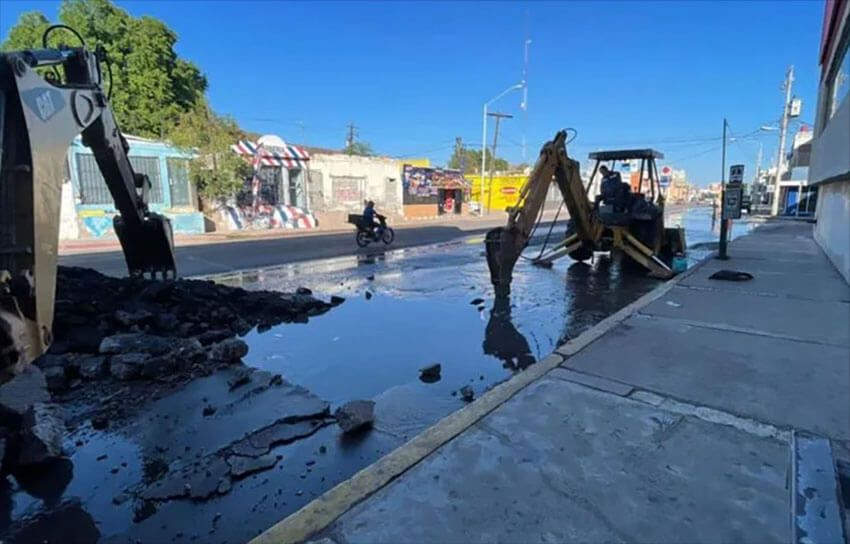The port city of Guaymas, Sonora, and the nearby beach town of San Carlos are plagued by a sewage crisis that is affecting people’s health.
The situation is so bad that Governor Alfonso Durazo declared a sanitary emergency last month, allocated almost US $500,000 to deal with the immediate crisis and promised to invest in a long-term solution.
The sewage system in Guaymas, a city of some 120,000 residents, is obsolete, neglected and riddled with leaks, clogs and broken pumps and pipes, according to a report by Phoenix radio station KJZZ and the Arizona Daily Star.
The situation during this year’s rainy season reached a “crisis point,” the report said.
Major roads in Guaymas were flooded with raw sewage and wastewater inundated arroyos near people’s homes after flowing out of manhole covers.

Much of the overflowing sewage ended up in the Gulf of California, located between the Baja California peninsula and the Mexican mainland. Sewage flowed constantly from a manhole cover into the sea for almost two weeks in San Carlos last month. Water quality testing has showed fecal bacterial levels as high as 350 times the legal limit.
The absence of wastewater treatment plants in both Guaymas and San Carlos only exacerbates the problem. Wastewater is only treated by oxidation lagoons that make use of the natural interactions between sunlight, algae, oxygen and bacteria. But the runoff from the lagoons remains highly contaminated.
Local authorities have been promising a treatment plant since at least 2008, but one has never been built.
“This [sewage crisis] never should have happened. It never should have happened because there should have been a program earlier to attend to the issue so we didn’t get to this situation,” said Sonora Infrastructure and Urban Development Minister Heriberto Aguilar.
“The problem is that there was no maintenance of the system, and now we’re in a serious situation, very serious,” the minister, part of a government that took office in September, told reporters.
“… It’s a crime against nature, and having sewage flowing through the center of the city is unworthy of the people. We never should have reached this point. It means we’ve failed,” Aguilar said.
Silvia Montero, a doctor who works in the public health system in Guaymas, told the Arizona news outlets that exposure to sewage can cause Hepatitis A, diarrhea, eye and skin irritation or infections and even cholera.
“It’s a huge problem. A lot of people are getting sick because of the sewage,” she said, adding that dried wastewater that becomes bacteria-laden dust can also cause illness.
Exposure to sea and fresh water contaminated with sewage can also cause health problems. In addition, fecal contamination in sea water can cause harmful algal blooms and kill marine life.
One Guaymas woman who lives near an arroyo that often fills with sewage that overflows from a clogged pipe said it was stressful and infuriating to be in close proximity to the untreated wastewater “because it smells horrible.”
Teresa Cortez lives with her four young grandchildren and all of them suffer from headaches due to the stench.
“And if I, an adult, a grown-up, can’t sleep because of the stink, just imagine! I have a three-year-old grandson, and another who’s four,” she told KJZZ and the Star.

“The smell gets in the house, even with everything closed up. We can’t sleep. They complain about headaches. Their eyes and noses sting because of the smell that gets inside.”
Tomás Thomas, co-owner of the Marvida brewery in San Carlos, said he’s worried about the impact the sewage problem will have on tourism as well as the public health risks.
“You get very sad when you see the sewage that’s going toward the ocean,” he said. “… It could definitely hurt business, you know, and the image of our brewery on the marina.”
Solving the sewage crisis, as the new Sonora government has pledged to do, will not be easy, the former chief of the state water commission said.
“We’ve always seen Guaymas as a very complicated, very complex system with a lot of challenges. A lot, a lot of challenges,” Ivan Cruz said. “All the challenges … there are in every other water operating system in Sonora, Guaymas has all of them,” he said.
Among the challenges, the report said, are “obsolete and poorly maintained infrastructure; shallow pipes due to the city’s rocky soil; and a hilly landscape that makes it difficult and costly to pump sewage to oxidation lagoons.”
Cruz said that more money is needed to improve the Guaymas sewage system, but the system’s rates are seen as too low and large numbers of residents don’t pay their bills in any case.
“The reality is that, even when the department brings in 100% of what it charges, even then it’s not enough to cover operating costs,” he said.
“That’s one of the biggest challenges for Guaymas, to update its water rates so that … [they] reflects the real costs and can break this vicious cycle and start investing in the system.”
While the new state government has pledged to address the immediate problems, modernize the Guaymas sewage system and build a wastewater treatment plant, some locals are skeptical it will deliver on its promise given the failure of previous officials to keep their word.
Claudia Fourcade, a 24-year-old resident said she hoped the authorities would do what they said they would but added, “the truth is, we don’t even know who to believe anymore.”
With reports from KJZZ and the Arizona Daily Star
